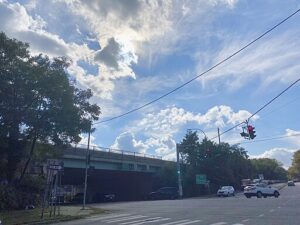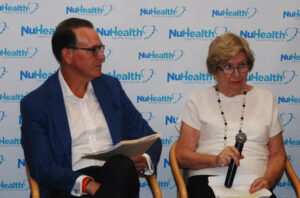By Melinda Rolls
Editor’s note: The following is part one of an investigative series examining the state of Long Island’s water supply.
Suffolk County’s sole aquifer used for drinking water is becoming increasingly at risk owing to the emergence of 1,4-dioxane, experts say.
1,4-dioxane is a particularly dangerous contaminant because it does not break down. Instead, it moves readily through soil and can completely mix with groundwater and potentially drinking water.
“Where we tend to see a problem above our maximum contaminant level is in places where there were former industrial operations, where 1,4-dioxane was released with other chlorinated solvents into the ground through external spills,” said Gary Ginsberg, director of the Center for Environmental Health at the New York State Department of Health in an interview with The Advocate.
Historically, western Suffolk was the site of many industrial and agricultural operations, leading to Suffolk having more 1,4-dioxane contamination problems in the western part of the county, closer to the border with Nassau County.

“The groundwater contamination is more of a legacy problem, stemming back decades,” said Ginsberg. “It’s not an ongoing process to release 1,4-dioxane into the ground.”
Some 1,4-dioxane has entered groundwater in recent years through personal products going down the drain, such as shampoos and cleaning products. 1,4-dioxane is not intentionally added to products, but is a byproduct most often found in products with suds.
According to an evaluation by the Citizens Campaign for the Environment, Suffolk’s water suppliers have reported some of the highest levels of 1,4-dioxane contamination in the nation. Citing health concerns of 1,4-dioxane groundwater contamination, New York State enacted regulations in 2019 that outlawed 1,4-dioxane in products sold in the state. As of Jan. 1, 2022, all but trace amounts of 1,4-dioxane in personal care products are banned.
“The groundwater contamination is more of a legacy problem, stemming back decades. It’s not an ongoing process to release 1,4-dioxane into the ground.”
Gary Ginsberg, State Department of Health
1,4-dioxane, a carcinogen?
The U.S. Department of Health and Human Services considers 1,4-dioxane as “reasonably anticipated to be a human carcinogen.”
With liver cancer rates more than doubling in New York since 1980, it is unknown if water contaminants are contributing to this increase. Owing to limited health data available for 1,4-dioxane, there is a lack of agreement on the acceptable risk levels of 1,4-dioxane in water.
The U.S. Environmental Protection Agency says that risk assessments indicate that 1,4-dioxane at a level of 0.35 micrograms per liter (ug/L) can be considered a cancer risk of one in a million.
Currently, there is no scientific evidence displaying a direct link between ingesting 1,4-dioxane and cancer in humans. However, animals used in laboratory studies ingesting 1,4-dioxane have shown a susceptibility to cancer. In a 2020 study that exposed rodents to water containing high doses of 1,4-dioxane for 90 days found the rodents had an increased predisposition to liver cancer.
New York became the first state to develop a maximum contaminant level for 1,4-dioxane in 2020 at 1.0 ug/L. Currently, there is no federal MCL for 1,4-dioxane.
“We set out a standard far below where any animal testing has shown there to be an actual health effect,” said Ginsberg. “We try to build in as much safety and precaution as we can.”
Treating 1,4-dioxane
As early as 2010, Long Island drinking water providers began discussing possible treatment options for 1,4-dioxane.
In 2017, the Suffolk County Water Authority completed construction of the first advanced oxidation process (AOP) for drinking water in New York to address 1,4-dioxane contamination concerns. The authority received approval from the state health department to bring the AOP system online in 2018.
“AOP is something that was helped developed by the Suffolk County Water Authority for New York State,” said Daniel Dubois, SCWA’s director of external affairs.
AOP is the only existing treatment method shown to effectively remove 1,4-dioxane. The process involves adding a small amount of hydrogen peroxide to the water and passing it through an ultraviolet light reactor to remove 1,4-dioxane molecules.
In typical water filtration, the SCWA uses a treatment called granulated activated carbon, which can remove herbicides, pharmaceuticals and chlorinated compounds in water.
The granulated activated carbon treatment “can remove pretty much everything but 1,4-dioxane,” said Thomas Schneider, SCWA’s director of water quality and laboratory services. “The challenge with 1,4-dioxane is it’s such a tough molecule to remove. It has to go through an advanced oxidation procedure. It has to break down in this reactor, and then we filter it out with the carbon.”
Currently, the SCWA has eight AOP systems in place in well fields throughout the Town of Huntington, and nine under construction throughout Suffolk.
According to the most recent SCWA laboratory data, 1,4-dioxane is present in 11 of the 24 distribution areas tested in Suffolk. Six out of the 24 distribution areas show an average 1,4 dioxane value of over the EPA’s health advisory level of 0.35 ug/L.

The highest average level of 1,4-dioxane is seen in Distribution Area 9, in northern Kings Park, at 1.01 ug/L. AOP systems are being installed in this area.
The installation of AOP systems has been an expensive undertaking for the SCWA. Not only are the AOP systems causing a rise in capital costs for the SCWA, but an increase in operational costs because of the increased labor required to maintain the systems.
“In an effort to reduce the costs for our customers, we’ve been pretty aggressive in seeking grant funding from New York State,” said SCWA Deputy CEO of Operations Joseph Pokorny. “We have been awarded $34 million in grant funding” in 2023.
Support for clean water
According to Suffolk County Legislator Bridget Fleming, the Suffolk Legislature has a committed group of elected officials who are supporting funding for clean water.
“I think folks are aware that we have a sole-source aquifer, and our drinking water comes from beneath our feet,” said Fleming. “If we don’t take care of it, there is no Plan B.”
On Nov. 21, the Suffolk County Legislature voted to pass an agreement with the Suffolk County Water Authority to provide $800,000 to alleviate concerns about contamination in private wells at 56 properties in the Town of Babylon. The authority plans to connect all the 56 properties to a new water system though the extension of water mains and service lines.
The SCWA is also gaining revenue from increased charges to Suffolk residents. As of Jan. 1, 2020, a $20 quarterly fee was added to all customer bills to pay for the cost of treatment systems for three contaminants: 1,4-dioxane, PFOS, and PFOA.
“This is probably one of the largest challenges that the Suffolk Water Authority has ever undertaken, to comply with these treatment systems in a very expedited fashion,” said Pokorny.









